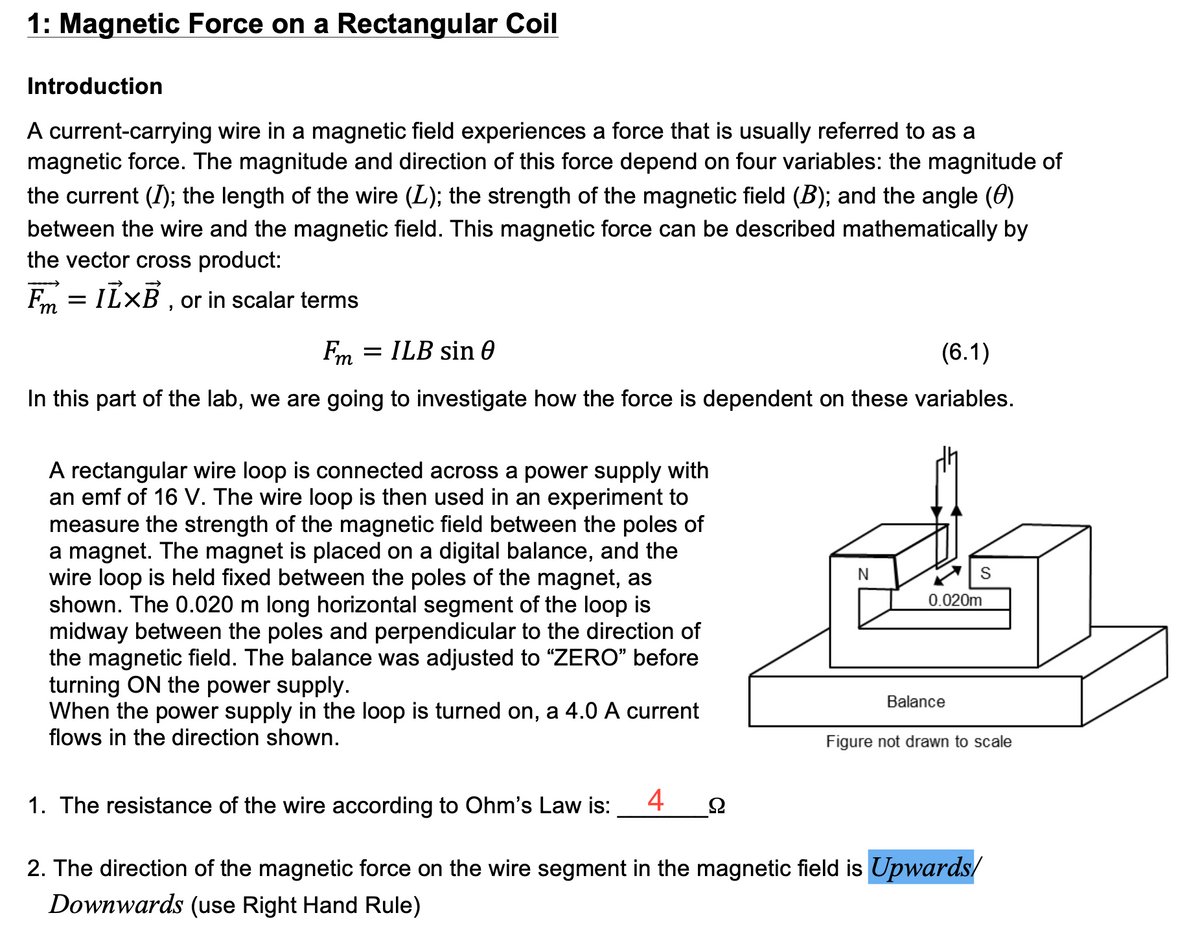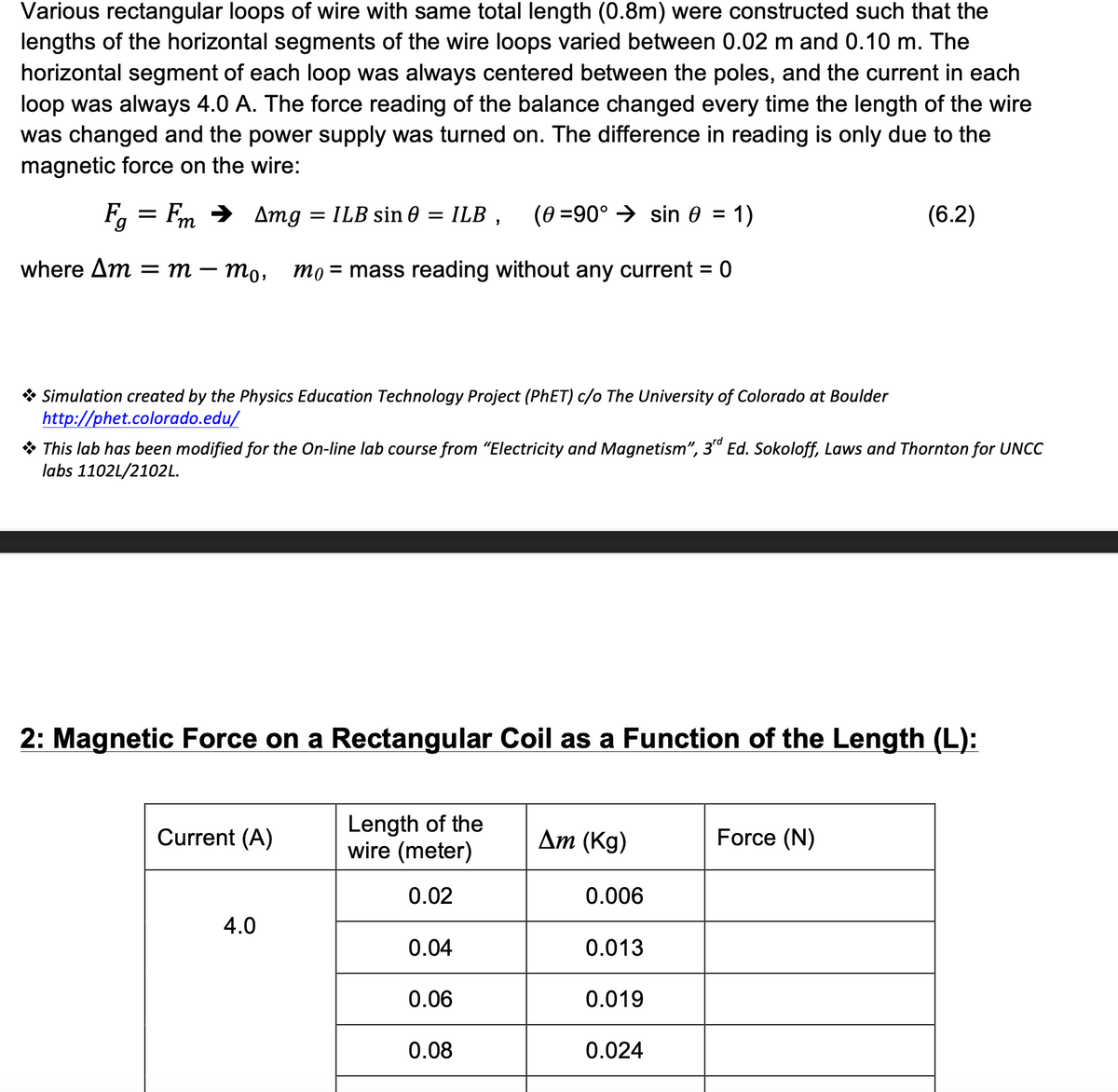2: Magnetic Force on a Rectangular Coil as a Function of the Length (L): Current (A) 4.0 Length of the wire (meter) 0.02 0.04 0.06 0.08 Δm (Kg) 0.006 0.013 0.019 0.024 Force (N)
2: Magnetic Force on a Rectangular Coil as a Function of the Length (L): Current (A) 4.0 Length of the wire (meter) 0.02 0.04 0.06 0.08 Δm (Kg) 0.006 0.013 0.019 0.024 Force (N)
College Physics
1st Edition
ISBN:9781938168000
Author:Paul Peter Urone, Roger Hinrichs
Publisher:Paul Peter Urone, Roger Hinrichs
Chapter22: Magnetism
Section: Chapter Questions
Problem 90PE: Construct Your Own Problem Consider a mass separator that applies a magnetic field perpendicular to...
Related questions
Question
I am working on a handout for physics homework and I am trying to fill in the table on the second image. I know that I need to used F = ILB, but I am not sure of how to obtain B in order to fill in the table. Help will be greatly appreciated, thank you!

Transcribed Image Text:1: Magnetic Force on a Rectangular Coil
Introduction
A current-carrying wire in a magnetic field experiences a force that is usually referred to as a
magnetic force. The magnitude and direction of this force depend on four variables: the magnitude of
the current (I); the length of the wire (L); the strength of the magnetic field (B); and the angle (0)
between the wire and the magnetic field. This magnetic force can be described mathematically by
the vector cross product:
F = ILXB, or in scalar terms
(6.1)
Fm
ILB sin 0
In this part of the lab, we are going to investigate how the force is dependent on these variables.
A rectangular wire loop is connected across a power supply with
an emf of 16 V. The wire loop is then used in an experiment to
measure the strength of the magnetic field between the poles of
a magnet. The magnet is placed on a digital balance, and the
wire loop is held fixed between the poles of the magnet, as
shown. The 0.020 m long horizontal segment of the loop is
midway between the poles and perpendicular to the direction of
the magnetic field. The balance was adjusted to "ZERO" before
turning ON the power supply.
When the power supply in the loop is turned on, a 4.0 A current
flows in the direction shown.
N
Ω
S
0.020m
Balance
Figure not drawn to scale
1. The resistance of the wire according to Ohm's Law is: 4
2. The direction of the magnetic force on the wire segment in the magnetic field is Upwards/
Downwards (use Right Hand Rule)

Transcribed Image Text:Various rectangular loops of wire with same total length (0.8m) were constructed such that the
lengths of the horizontal segments of the wire loops varied between 0.02 m and 0.10 m. The
horizontal segment of each loop was always centered between the poles, and the current in each
loop was always 4.0 A. The force reading of the balance changed every time the length of the wire
was changed and the power supply was turned on. The difference in reading is only due to the
magnetic force on the wire:
Fg = Fm → Amg = ILB sin 0 =
(0 =90° sin 0 = 1)
where Am = m - mo, mo= mass reading without any current = 0
❖Simulation created by the Physics Education Technology Project (PhET) c/o The University of Colorado at Boulder
http://phet.colorado.edu/
ILB,
This lab has been modified for the On-line lab course from "Electricity and Magnetism", 3rd Ed. Sokoloff, Laws and Thornton for UNCC
labs 1102L/2102L.
Current (A)
2: Magnetic Force on a Rectangular Coil as a Function of the Length (L):
4.0
Length of the
wire (meter)
0.02
0.04
0.06
0.08
Am (Kg)
0.006
0.013
0.019
(6.2)
0.024
Force (N)
Expert Solution
This question has been solved!
Explore an expertly crafted, step-by-step solution for a thorough understanding of key concepts.
This is a popular solution!
Trending now
This is a popular solution!
Step by step
Solved in 2 steps with 2 images

Knowledge Booster
Learn more about
Need a deep-dive on the concept behind this application? Look no further. Learn more about this topic, physics and related others by exploring similar questions and additional content below.Recommended textbooks for you

College Physics
Physics
ISBN:
9781938168000
Author:
Paul Peter Urone, Roger Hinrichs
Publisher:
OpenStax College

Physics for Scientists and Engineers, Technology …
Physics
ISBN:
9781305116399
Author:
Raymond A. Serway, John W. Jewett
Publisher:
Cengage Learning

College Physics
Physics
ISBN:
9781285737027
Author:
Raymond A. Serway, Chris Vuille
Publisher:
Cengage Learning

College Physics
Physics
ISBN:
9781938168000
Author:
Paul Peter Urone, Roger Hinrichs
Publisher:
OpenStax College

Physics for Scientists and Engineers, Technology …
Physics
ISBN:
9781305116399
Author:
Raymond A. Serway, John W. Jewett
Publisher:
Cengage Learning

College Physics
Physics
ISBN:
9781285737027
Author:
Raymond A. Serway, Chris Vuille
Publisher:
Cengage Learning

College Physics
Physics
ISBN:
9781305952300
Author:
Raymond A. Serway, Chris Vuille
Publisher:
Cengage Learning


Physics for Scientists and Engineers: Foundations…
Physics
ISBN:
9781133939146
Author:
Katz, Debora M.
Publisher:
Cengage Learning